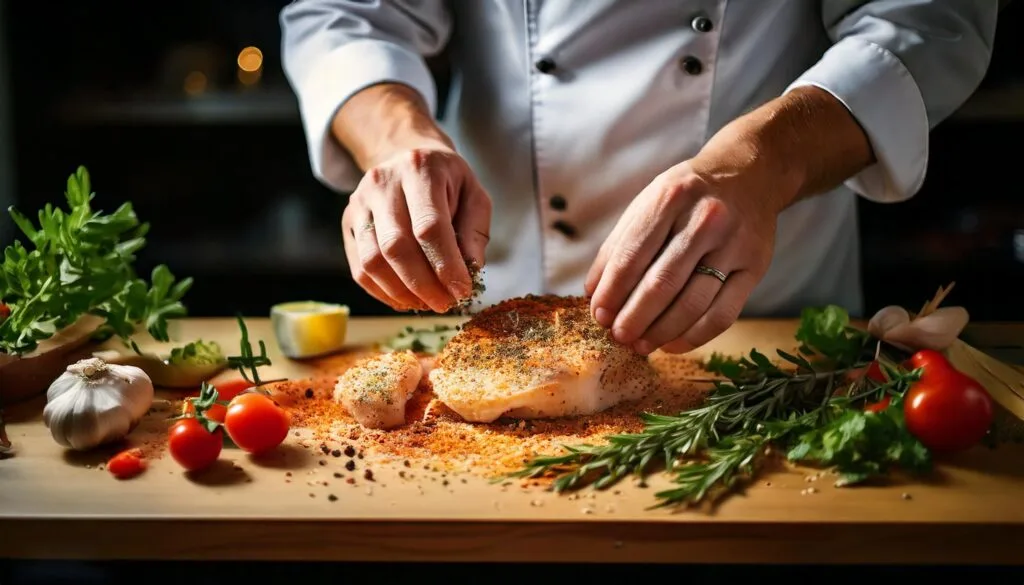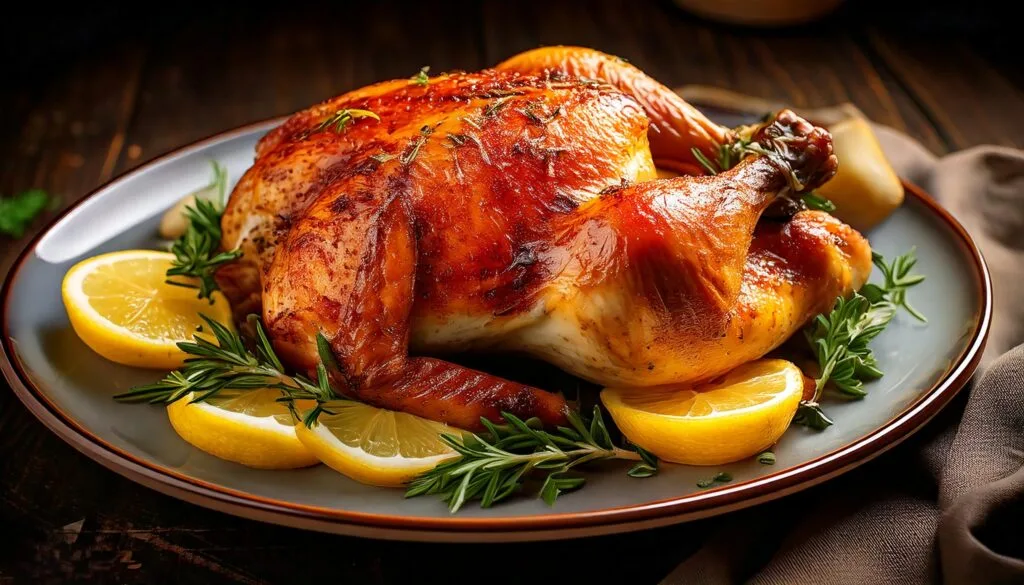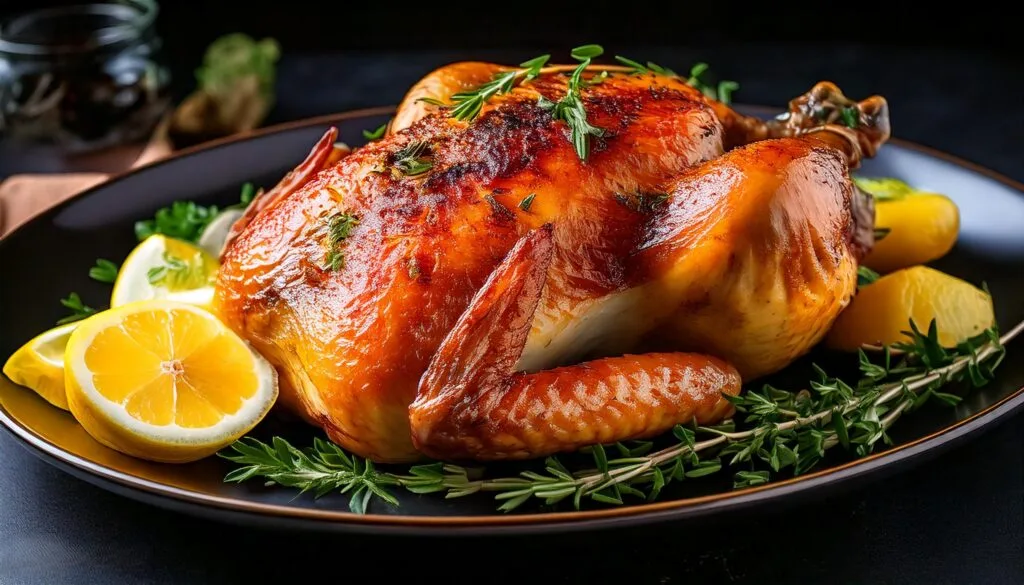How to Cook Chicken Like a Chef: Cooking chicken like a chef might seem intimidating at first, but with the right preparation, tools, and techniques, you can transform this humble protein into a restaurant-worthy dish. From selecting the freshest ingredients to using professional cooking methods, this guide will walk you through everything you need to know. Whether you’re a home cook or a kitchen newbie, you’ll learn the secrets that chefs use to make chicken juicy, flavorful, and perfectly cooked every single time.
Introduction
Why Cooking Chicken Like a Chef Is a Game-Changer
Chicken is a favorite in professional kitchens, not just for its versatility but also for its ability to take on bold flavors. However, it’s surprisingly easy to overcook or underseason, leaving you with dry, bland results. This section dives into the basics, explaining why proper techniques matter and how they can elevate your cooking.
Why Chefs Love Cooking Chicken
- Chicken is a blank canvas: it works with herbs, spices, and sauces from any cuisine.
- It’s protein-packed, affordable, and suitable for all diets (when prepared thoughtfully).
- Mastering chicken is a foundation skill for aspiring chefs.
The Challenges of Cooking Chicken
Even seasoned cooks struggle with issues like uneven cooking, dryness, and bland flavor. But don’t worry these can be tackled with the pro tips you’ll learn in this guide.
Preparation Techniques
Choosing the Right Chicken: Quality Matters
The foundation of any great chicken dish starts with selecting the right bird. Chefs are meticulous about this step because quality affects both taste and texture. Always opt for fresh chicken, ideally free-range or organic, to ensure the best flavor.
- Look for clear packaging and firm flesh. Avoid chicken that has an unpleasant odor or looks slimy.
- Know your cuts: Whole chickens are versatile, but if you’re looking for convenience, choose parts like thighs for richness or breasts for leanness.
- Freeze properly: If you’re storing chicken, keep it in an airtight bag to prevent freezer burn.
Related Resource: Check out this detailed guide on choosing the best chicken for different recipes.
Essential Tools for Cooking Chicken
You can’t cook chicken like a chef without the right tools in your kitchen arsenal. These are the chef-approved must-haves:
- Chef’s knife: For trimming fat, deboning, and slicing.
- Meat thermometer: A lifesaver to ensure your chicken is cooked safely (internal temp: 165°F).
- Heavy-duty skillet or cast iron pan: Ideal for achieving a perfect sear.
- Cutting board: Use separate boards for raw chicken to avoid cross-contamination.
Investing in quality tools not only improves your results but also makes cooking more enjoyable.
Prepping the Chicken Like a Pro
Once you’ve chosen your chicken and gathered your tools, it’s time to prepare. Chefs swear by these steps:
- Clean and pat dry: Rinse lightly and pat the chicken dry with paper towels for better browning.
- Trim excess fat: Use your chef’s knife to remove any skin or fat you don’t want in the dish.
- Debone for certain recipes: If your recipe calls for even cooking, deboning ensures there are no uneven portions.
Pro Tip: Save the bones for making homemade chicken stock later!
The Secret to Tender Chicken: Brining
If there’s one technique that transforms chicken, it’s brining. Brining infuses moisture into the meat and helps it cook evenly.
- Wet brine: Soak the chicken in saltwater (add herbs for extra flavor) for a few hours.
- Dry brine: Rub the chicken with kosher salt and let it rest in the fridge overnight.
Why brining matters: It locks in juices, ensures seasoning penetrates deep, and enhances tenderness.To make your chicken even more tender, check out our tips on how to cook chicken very tender
Marinating Tips for Irresistible Flavor
Marinades take chicken to the next level by adding complexity to the flavor. Chefs use a balance of:
- Acid: Lemon juice, vinegar, or yogurt to tenderize the meat.
- Oil: Olive oil or avocado oil to keep it moist.
- Herbs and spices: Garlic, rosemary, paprika, or even turmeric for a unique twist.
Pro Tip: Let the chicken marinate for at least 30 minutes, but no longer than 24 hours to avoid breaking down the texture.
Chef-Approved Cooking Methods for Perfect Chicken

The Art of Searing: Getting That Golden-Brown Crust
Chefs swear by searing as the first step for many chicken recipes. It locks in flavor and creates a beautiful golden-brown crust. Here’s how to do it right:
- Preheat your pan: Use medium-high heat and add a high-smoke-point oil like avocado or vegetable oil.
- Dry chicken = crispy skin: Pat the chicken dry before placing it in the pan to prevent steam.
- Don’t overcrowd the pan: Searing in batches ensures the chicken gets proper contact with the heat.
Once seared, you can finish cooking in the oven or simmer it in a sauce for a full-flavored dish.
Baking and Roasting for Juicy Results
Oven cooking is a foolproof method for consistent results. Here’s what chefs recommend:
- Preheat correctly: Always preheat your oven to the recipe’s temperature, typically 375°F-425°F.
- Use a rack: Elevating the chicken ensures heat circulation for even cooking.
- Baste periodically: Spoon pan juices over the chicken every 10-15 minutes for maximum moisture.
Pro Tip: Roast chicken with skin-on to retain juices and develop a crispy, flavorful exterior.
Poaching: A Chef’s Secret to Tender Chicken
Poaching may not sound exciting, but chefs love this gentle technique for its unmatched tenderness. Steps include:
- Bring water or chicken broth to a gentle simmer (not boiling!).
- Add aromatics like garlic, bay leaves, or thyme for added flavor.
- Submerge chicken breasts and cook for 12-15 minutes until tender and juicy.
Poached chicken is perfect for salads, sandwiches, or shredded dishes like tacos.
Grilling Chicken Like a Pro
Want that smoky, charred flavor? Grilling is your answer:
- Oil the grates: Prevent sticking and achieve those Instagram-worthy grill marks.
- Indirect heat for thicker cuts: Start with direct heat for searing, then move to indirect heat to cook through.
- Monitor the temperature: Use a thermometer to avoid overcooking.
Chef’s Tip: Brush the chicken with a marinade or glaze during the last few minutes to create a caramelized coating.
Sautéing: Quick and Flavorful
Sautéing is a fast, go-to method for chefs when time is tight:
- Use a hot pan: Heat the oil until it shimmers, then add chicken pieces in an even layer.
- Add aromatics: Toss in garlic, onions, or fresh herbs to infuse extra flavor.
- Deglaze the pan: Use chicken broth or lemon juice to create a quick sauce from the pan drippings.
Advanced Chicken Cooking Techniques

Sous Vide: The Ultimate Precision Cooking Method
Sous vide is a technique that chefs use for perfectly cooked chicken every time. This method uses precise temperature control to ensure your chicken stays tender, juicy, and cooked exactly to your liking. Here’s how to do it like a pro:
- Prepare the chicken: Season it with salt, pepper, and your choice of herbs.
- Seal in a vacuum bag: Place the chicken in a vacuum-seal bag and remove all air.
- Cook at low temperature: Heat a sous vide bath to 140°F for chicken breasts or 165°F for thighs, and cook for 1-2 hours.
Why sous vide? It eliminates the risk of overcooking and delivers a perfectly even cook from edge to edge. After sous viding, you can sear the chicken in a hot pan for a crispy exterior.
Pro Tip: If you don’t have a sous vide machine, a large pot of water can work as an alternative. Just use a thermometer to monitor the temperature carefully.
Chicken Braising: Slow-Cooked Flavor
Braising involves cooking chicken slowly in a flavorful liquid, resulting in tender, fall-off-the-bone meat. This method works wonders for tougher cuts like thighs or legs. To braise:
- Sear the chicken first: Get that crispy, golden-brown crust by searing the chicken in a hot pan.
- Add liquid: Pour in broth, wine (or vinegar), and vegetables to create the braising liquid.
- Slow cook: Let the chicken cook on low heat for about 45 minutes to 1 hour.
The key to successful braising is patience. The slow cooking process makes even tough chicken cuts incredibly tender.
The Science of Seasoning: How to Flavor Your Chicken
Chefs know that the right seasoning can make or break a chicken dish. But what exactly makes seasoning so important? Let’s break it down:
- Salt enhances natural flavors: Salt is the most important seasoning you can use. It brings out the natural umami in chicken and improves texture.
- Layering flavors with herbs and spices: Use fresh herbs like rosemary, thyme, or basil for a fragrant taste. Spices like paprika, garlic powder, and cayenne pepper can add depth.
- Season early: Whether you’re brining, marinating, or dry seasoning, allowing the chicken to absorb flavors beforehand will lead to a richer dish.
Pro Tip: For an extra boost, finish the chicken with a squeeze of lemon juice or a drizzle of olive oil just before serving.
Elevating Chicken Dishes with Sauces and Garnishes
The Magic of Sauces: Unlocking Rich Flavors
A great sauce is like the finishing touch to a well-cooked chicken dish. Whether you’re making a rich cream sauce, tangy marinade, or bold barbecue glaze, it’s all about balance. Here’s how to master sauce-making:
- Reduce for concentrated flavor: Start by simmering your liquid to reduce it down to a rich, concentrated base.
- Incorporate butter for richness: A dollop of butter or a splash of cream can add smoothness and balance acidity in sauces.
- Use stock or broth: Chicken stock or vegetable broth adds depth to your sauces, making them the perfect complement to any chicken dish.
Chef Tip: Always taste your sauce before serving! A pinch of salt, sugar, or even vinegar can fine-tune the flavors. If you’re a fan of creamy sauces, you might also love our guide on sweet cream.
Some classic sauces to pair with chicken:
- Gravy: For comfort food lovers, the classic chicken gravy is always a hit.
- Beurre Blanc: A French butter-based sauce that’s delicate but incredibly flavorful.
- Barbecue Sauce: Smoky, sweet, and spicy, it pairs beautifully with grilled or roasted chicken.
- Lemon Butter Sauce: A simple yet elegant choice for pan-seared chicken.
Garnishes: Adding the Finishing Touches
While sauces enhance flavor, garnishes elevate the visual appeal of your dish. Chefs know the importance of texture and color contrast. Here’s how to perfect your garnishing skills:
- Fresh herbs: A sprinkle of fresh parsley, cilantro, or thyme brightens up any dish.
- Toasted nuts or seeds: Toasted almonds, sesame seeds, or sunflower seeds add crunch and flavor.
- Citrus zest or wedges: A zest of lemon or lime offers a pop of freshness and color.
- Sautéed greens: Sauteeing spinach, kale, or arugula in olive oil adds both color and a burst of flavor.
Remember, a good garnish should complement-not overpower-the dish. It should also provide some texture contrast, like a crunchy topping on a tender piece of chicken.
Perfect Pairings: Choosing the Right Side Dishes for Chicken
Vegetables: The Perfect Balance to Chicken’s Richness
Pairing chicken with vegetables not only balances the dish but also adds layers of flavor and texture. Here are some great vegetable sides that work wonders with various chicken dishes:
- Roasted Vegetables: Roasting vegetables like carrots, bell peppers, and zucchini brings out their natural sweetness, which complements savory chicken perfectly.
- Steamed Asparagus: Lightly steamed asparagus has a delicate, fresh flavor that pairs well with grilled or roasted chicken.
- Sautéed Spinach or Kale: These leafy greens have a slightly bitter taste that cuts through the richness of chicken, providing a perfect balance.
Chef Tip: Add garlic, shallots, or a squeeze of lemon to your vegetables for an extra pop of flavor!
Starches: Comfort Food at Its Best
Starches like potatoes, rice, and pasta are classic choices to accompany chicken dishes. These carbs soak up all the delicious juices from your chicken, making them a comforting and satisfying addition. Here are some ideas:
- Mashed Potatoes: Creamy mashed potatoes, with a dollop of butter or cream, provide a velvety contrast to the texture of chicken.
- Rice Pilaf: A fragrant rice pilaf made with herbs and broth can elevate a simple chicken dish to something spectacular.
- Buttery Biscuits or Rolls: Soft, flaky biscuits or dinner rolls are perfect for mopping up any sauces or gravy left on the plate.
Fresh Salads: A Light, Refreshing Touch
For a lighter option, pair your chicken with a fresh salad. It adds a crisp, refreshing element that balances out the richness of the meat. Here are some great salad ideas:
- Caesar Salad: The classic Caesar, with its creamy dressing and crunchy croutons, is an excellent pairing with roasted or grilled chicken.
- Mixed Green Salad: Toss together some arugula, spinach, and romaine with a tangy vinaigrette for a bright contrast.
- Coleslaw: A tangy, slightly sweet coleslaw adds crunch and balances out a smoky or spicy chicken dish.
Grain-Based Sides: Adding Texture and Flavor
Grains are often overlooked, but they provide a great base for chicken. Here are some grain-based side dishes that chefs often serve alongside chicken:
- Quinoa: Light, fluffy quinoa is a nutritious and versatile grain that pairs beautifully with chicken, especially grilled or roasted varieties.
- Couscous: This light and airy grain can absorb any sauce from your chicken, making it a perfect accompaniment for dishes with rich sauces.
- Polenta: Creamy polenta, made with cornmeal, adds a comforting and creamy element to chicken, especially when paired with braised or roasted chicken.
The Art of Plating: Making Your Chicken Dishes Shine

Plating 101: Setting the Stage for Your Dish
Plating is one of the most important aspects of cooking like a chef. After all, we eat with our eyes first! Here’s how to master the basics of plating:
- Use the Right Plate Size: Start by choosing the right size plate to avoid making the dish look too crowded or too sparse. For a well-presented dish, a larger plate helps keep your chicken and sides neatly arranged.
- Balance is Key: A good plate should have balance in both color and shape. Try to create contrast between your chicken, vegetables, and starches. For example, pair a crispy golden brown chicken breast with a vibrant green vegetable and some creamy mashed potatoes.
- Symmetry vs. Asymmetry: While symmetry is classic and easy to follow, playing with asymmetry can give your plate a more modern and artistic look. Don’t be afraid to experiment!
Chef Tip: To give your chicken dish a professional finish, make sure you clean the edges of the plate. A little wipe can elevate the presentation instantly.
Elevating with Garnishes and Final Touches
Garnishes are the final step in making your chicken dish look restaurant-worthy. They serve as both a visual pop and an added layer of flavor. Here are a few ideas for elevating your plating:
- Sprinkle Fresh Herbs: Fresh herbs like basil, rosemary, thyme, or parsley can brighten up any chicken dish and provide a burst of freshness.
- Add Colorful Elements: Think about adding vibrant elements, such as a splash of pomegranate seeds, a drizzle of sauce, or thin slices of citrus. These color pops can instantly make your plate look more inviting.
- Layering Ingredients: Don’t just dump your chicken and sides together. Try stacking or layering to create a more sophisticated look. For example, you can place your chicken on top of a bed of rice or polenta to add height and visual interest.
The Final Touch: Sauce Presentation
Sauce isn’t just for flavor it’s an essential element of your presentation. Here’s how to make sure your sauce stands out on the plate:
- Drizzle, Don’t Drown: When adding sauce to your chicken, keep it light. Drizzle the sauce artistically over the chicken or around the edges of the plate.
- Use a Spoon or Brush: If you’re going for a fine-dining look, use a spoon to drizzle the sauce in small, controlled amounts. For a more artistic presentation, you can use a brush to create clean streaks on the plate.
By mastering the art of plating, you can ensure your chicken dishes look as impressive as they taste. In the next section, we’ll wrap up with some common questions people have about cooking chicken like a chef.
FAQs: Cooking Chicken Like a Chef
1. What’s the best way to season chicken for maximum flavor?
Seasoning is key when cooking chicken like a chef. The best approach is to use a mix of salt, pepper, and fresh herbs. For deeper flavor, marinate the chicken for at least 30 minutes to an hour before cooking. Common seasonings for chicken include garlic, thyme, rosemary, paprika, and lemon zest. For a more intense flavor, try brining your chicken overnight to enhance juiciness and tenderness. Be sure to season both the inside and outside for full flavor!
2. How do chefs cook chicken so it’s always tender and juicy?
Chefs achieve tender, juicy chicken by controlling temperature and cooking time. One of the secrets is cooking the chicken at medium heat instead of high heat, preventing it from drying out. Using a meat thermometer is a foolproof way to ensure it’s cooked to perfection. For chicken breasts, aim for 165°F (74°C) in the thickest part. Roasting, braising, and pan-searing are popular methods to lock in moisture while creating a crispy outer layer.
Pro Tip: Let your chicken rest for about 5-10 minutes after cooking so the juices redistribute evenly throughout the meat.
3. What are the most common mistakes to avoid when cooking chicken?
Some common mistakes include overcooking or undercooking the chicken, using too little seasoning, and not letting the chicken rest after cooking. Overcooking dries out the meat, while undercooking can lead to foodborne illness. Also, skipping the resting period after cooking results in loss of moisture. For crispy skin, avoid moving the chicken too much during the cooking process, and ensure it’s completely dry before cooking.
4. Can I cook chicken breast and thighs the same way?
Not quite! Chicken breasts are leaner, while thighs have more fat, so they cook differently. Breasts cook faster and require a gentler heat to avoid dryness. Thighs, on the other hand, are more forgiving and can be cooked at higher temperatures. If you’re cooking both, consider adjusting the cooking time or searing thighs before adding breasts to the pan.
5. How can I get crispy chicken skin like a chef?
Achieving crispy chicken skin is all about rendering the fat properly. Start by patting the skin dry to remove excess moisture. When cooking, use high heat and don’t overcrowd the pan, which can trap steam and make the skin soggy. If roasting, you can brush the skin with a thin layer of oil or butter before cooking to help it crisp up. For the crispiest skin, make sure your oven is fully preheated.
Chef’s Tip: Use a cast-iron skillet to get an even, crispy texture when pan-searing chicken.
6. How do I prevent dry chicken?
To prevent dry chicken, consider marinating or brining your chicken before cooking. This helps lock in moisture. Additionally, cooking chicken to the correct temperature (165°F for breasts, 180°F for thighs) is crucial. For cooking techniques, slow-cooking, poaching, or roasting chicken with a lid on will help maintain its moisture throughout the cooking process. Avoid overcooking, and always let your chicken rest after it’s done.
Pro Tip: If you’re making a chicken breast, consider pounding it to an even thickness so it cooks evenly without drying out.
